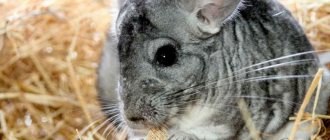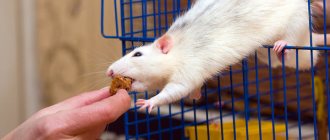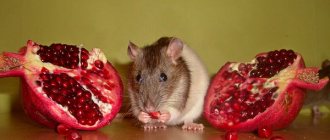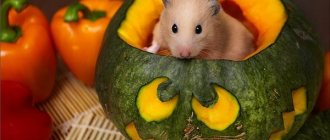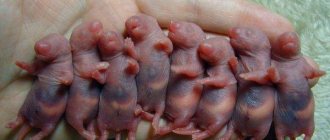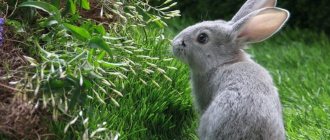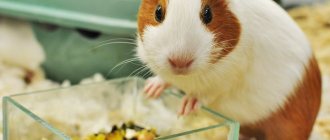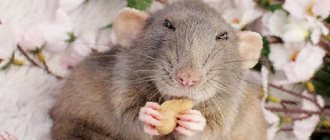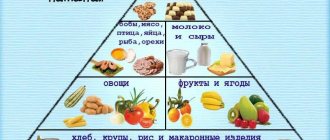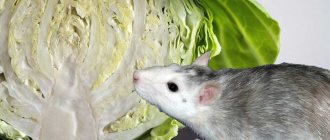- home
- Chinchilla
- Nutrition
04/03/2019 Chinchilla is a vegetarian by nature. She eats everything that the sparse but varied vegetation of her homeland, the highlands of the Andes, provides. In home-keeping conditions, owners try to choose the right products included in the animal’s diet. In addition to pellets and hay, the animals eat berries, dried vegetables and fruits, and gnaw twigs and twigs of trees and shrubs. Wanting to balance their pet's diet, owners are interested in whether chinchilla seeds are good for them.
There is no definite answer to the question, so you need to learn more about the different types of such delicacies and decide whether to introduce it to the rodent’s menu.
The right diet for a chinchilla
Experts in breeding rodents of this species recommend using granulated food. A half-kilogram package of food for an adult animal will last for a month and a half. After opening the pack, you need to move its contents into a container that has an airtight lid. This way the food will be kept fresh without losing its beneficial properties.
Pelleted food is beneficial due to its similarity to animal food in the natural environment. It contains a high amount of grains, herbs and vegetables.
The positive side of granular food is its hard consistency, thanks to which the animal can wear down its teeth while eating food.
An essential component in a chinchilla's home is hay. For the comfort of the pet, a special hay mat is used, which can be purchased at a pet store. The total amount of hay should not be more than pellets. Such a nutritional supplement for animals, in principle, can be prepared personally by the owner, but experts recommend using products from pet stores. The bottom line is that most grass is unsuitable for chinchillas to eat. A pet can get poisoned and have problems with the digestive system.
Properly collected hay consists of fresh green herbs, not overdried, but not damp leaves, and has the smell of cut grass, and not dampness, fungus or mold.
It is extremely difficult to find such filler in the store, and if you come across it, it is only during haymaking. It is quite possible to store it in a warehouse, but within a few months the fresh collection of herbs produces inedible biomass, suitable only as bedding. Therefore, it is more expedient to prepare grass reserves for the whole year on your own. If you use store-bought options, purchases must be made at the beginning of summer. You need to organize a place to store it yourself, using all the above recommendations.
Not a single animal will refuse treats and complementary foods, which can be purchased in the shopping center in the form of granules. Auxiliary elements of the diet differ from the main granulated food in color and softness. The supplement is enriched with a number of minerals, amino acids and vitamins. Complementary feeding helps strengthen the immune functions of the body and the heart rate of the soft lump, and also has a positive effect on the circulatory system. Experts say that additional components of the diet can be obtained personally. This requires a certain amount of cereals, roots, berries and leaves. All of the above elements are added to the feed in dry form.
Owners of furry rodents are interested in the question of whether chinchillas can eat seeds. It is impossible to give any single answer to this question. After all, seeds also come in different types. Let's look at each one separately.
Apple seeds
The diet of herbivores, such as chinchillas, includes fruits. One of the favorite foods of rodents is apples. They are offered to animals in a dried or dried form so as not to cause digestive upset.
There is no need to peel the core of these fruits. If an animal eats a few small seeds from it along with a piece of apple, nothing bad will happen. Recent studies suggest that apple seeds contain substances that can prevent cancer. As a preventive measure, a person is recommended to consume 4-5 seeds daily.
Chinchillas only need a few seeds eaten with an apple. You should not store them specifically and offer them to animals as a separate dish.
Sunflower grains
Animals living in a house or apartment lose their survival skills in nature. Therefore, it is a big mistake to hope that the animals know on their own what they can eat and what they cannot. And if you give your chinchilla roasted seeds, she will eat them with pleasure. However, you don’t need to follow your pet’s lead! Experts note that chinchillas are not recommended to consume sunflower seeds.
Roasted seeds are especially harmful to rodents. Since rodents simply cannot find such food in their natural environment, their digestive system is not adapted to this food. You can give the seeds raw, but in limited quantities. Raw sunflower seeds contain a large amount of fatty acid, which has a positive effect on the chinchilla's coat. Due to the high level of fat content of this product, the animal may develop indigestion. There is a high risk of constipation and intestinal infections, as well as the development of obesity, so you should not feed your pet seeds often.
Herb seeds
In nature, rodents feed on grasses, eating their seeds. This means that they also need this natural food at home.
Flax seed can be given in small doses to improve digestion. Plantain together with seeds has a good effect on the organs of the gastrointestinal tract. Nursing females will benefit from fennel seed; it promotes lactation. Any herbaceous plants recommended for inclusion in a pet's diet can be given with ripened seeds.
What other seeds can you give?
The chinchilla's diet can be expanded with the help of other seeds. The main thing is to observe moderation - give the fluffies seeds only as a treat. After all, if the animal is not limited, it can overeat until it becomes ill. Chinchillas will like the following types of seeds:
- Squash . They contain the substance santonin, which is used to remove worms and other endoparasites. They are also rich in vitamins B, C, E, K, P, therefore they strengthen the immune system and improve mood. They help improve the functioning of the urinary tract, promote the activation of hematopoietic function, and stabilize the psycho-emotional state.
- Linen . They have a very useful composition. Contain mineral compounds (sodium, magnesium, zinc, manganese, calcium, potassium), vitamins (pantothenic, ascorbic, nicotinic acids, riboflavin, choline, thiamine). Improve digestion, increase metabolic rate, lower blood pressure. Have a beneficial effect on the organs of the reproductive system. Effective for treating constipation.
- Sesame . Contains sesamin and sesamolin - compounds that reduce the level of bad cholesterol in the blood and strengthen the walls of blood vessels. They also have a beneficial effect on the liver, joints and organs of the nervous system.
- Appleaceae . They contain potassium, calcium, iodine, iron, flavonoids, as well as vitamins B, C, E, PP. Thanks to antioxidants, they prevent the development of cancer. It is worth considering that apple seeds should not be given to pregnant chinchillas.
- Milk thistle seeds . Rich in vitamins, minerals, flavonoids, antioxidants, enzymes. They normalize the functioning of the digestive system, strengthen the heart muscle, and remove waste and toxins.
It is also worth noting that if there are doubts about the quality of the raw materials used for preparation, it is better to treat the chinchilla only with purchased specialized treats. They are not expensive. And taking into account the restrictions on the quantity allowed for chinchillas, a package weighing 100 g will last for at least six months.
Can pumpkin be harmful?
Contains a large amount of fiber. It is not recommended for daily use by hamsters.
If you feed your hamster pumpkin more and more frequently, changes in the color of the rodent's coat may occur. So, for example, the fur of a white hamster will turn yellow, a cream hamster will turn orange, and a black hamster will turn brown.
Rules for self-harvesting branches
When buds appear on the trees, you can begin harvesting branches. They are cut with pruning shears. The sap moving through the trees at this time has the most valuable nutritional composition.
- Only living branches are taken from healthy trees and shrubs. Animals that are dried out, dirty, moldy or have marks of teeth cannot be cut off. The stems of raspberries, gooseberries, and hawthorns must be cleared of sharp thorns so that the animal does not injure the oral cavity.
- The branches (about 1 cm in diameter) are divided into parts 5–7 cm long. This size is convenient for a chinchilla, who eats while sitting and holding the treat in her front paws.
- The chopped twigs are washed well and doused with boiling water. Dry in the oven, placing it on a baking sheet in a thin layer.
- The oven door is left slightly open. The sticks are checked and mixed periodically.
- Completely dried branches are stored in cardboard boxes. Plastic containers are not suitable for this; they can become moldy there. Well-dried wood will not mold. However, after a few weeks you need to check the twigs - those infected with mold are thrown away, the rest are dried.
List of "Do's and Don'ts"
Re: List of "Do's and Don'ts"
Message number: #161 Ivanovna » Sat Jun 25, 2011 13:13
If you do not want to see this block, register or log in under your name.
Re: List of "Do's and Don'ts"
Message number: #162 Marina Lepel » Sat Jun 25, 2011 14:25
Re: List of "Do's and Don'ts"
Message number: #163 Ivanovna » Sat Jun 25, 2011 14:36
Re: List of "Do's and Don'ts"
Message number: #164 lavina » Sun Jun 26, 2011 15:56
vice versa! Thank you very much for your complete and detailed answer!
By the way, the other day I bought additional food (I don’t even know how to translate it correctly) for chinchillas, it’s called “flower field”. So it contains sunflower petals and marigolds. Moreover, marigolds are already just boxes with seeds. mine just attacked them first
Re: List of "Do's and Don'ts"
Message number: #165 Love » Tue Jul 05, 2011 18:56
Re: List of "Do's and Don'ts"
Message number: #166 koda » Tue Jul 05, 2011 20:46
Re: List of "Do's and Don'ts"
Message number: #167 Passerby » Tue Jul 05, 2011 22:42
I’ve never given them one yet (I just can’t get around to buying them especially for Nyusha), but for myself (as a result of scouring various chinchilla sites) I came to the same conclusion as koda - no more than two medium or one large sunflower seeds per week. I think that (despite the undeniable abundance of useful substances) they should not be abused due to the significant amount of oil they contain.
By the way, I wanted to ask one more question in connection with pumpkin seeds. It is generally accepted that they are a good prophylactic anthelmintic (anthelminthic) agent. But then I came across an indication that pumpkin seeds are used “against various tapeworms” [emphasis added]. This is where the question came to me. I know that, in general, the variety of helminths is not limited only to tapeworms, but what kind of helminths are found in hornets and can hornworms have tapeworms? Or maybe the anthelmintic properties of these seeds are no more important for our jokers than a strong lock on the display case doors?
Bottom line
After reading this article, you found out exactly whether chinchillas can have seeds, which ones to give and in what quantity. I cannot deprive the chinchilla of the pleasure that she experiences while eating seeds, so I always try to treat her once a week.
Control the amount of seeds fed and make sure, if you have children, that they do not feed their pet. Children are very kind, so from the pure heart they bring the chinchilla an unlimited amount of seeds, treats, sweets, etc.
Authorized Products
The list of foods that can be given to chinchillas is quite large. Animals can be fed fruits:
- Bananas,
- Apples,
- Pears,
- Figs
- Vegetables:
- Pumpkin,
- Milk corn,
- Bell pepper,
- Kohlrabi,
- Zucchini,
- Zucchini,
- Kohlrabi,
- Patissons,
- Ripe red tomatoes.
Greenery:
- Lettuce leaves,
- spinach leaves,
- Clover,
- Alfalfa,
- sorrel leaves,
- Dandelion leaves and stems,
- Celery,
- Chicory,
- Cornflowers,
- Vika,
- Common nettle,
- Sagebrush,
- Raspberry leaves and stems
- Strawberry leaves and stems
- Plant tops,
- Twigs with leaves of apple, pear,
- Birch and linden branches,
- Hazelnut sprigs.
- Corn (corn grains are part of the feed mixture and are given in ground form),
- Barley (given in ground form),
- Wheat (grains and bran),
- Oats (grains, bran, flakes),
- Millet,
- Buckwheat,
- Rice.
- Soybean,
- Peas,
- Beans,
- Red and white beans,
- Lentils.
Apples, pears, as well as carrots, pumpkins, zucchini, berries can be given to animals both fresh and dried.
Some chinchillas are more willing to eat dried foods, and they are also safer for the digestive tract.
It is recommended to collect fresh grass for furry pets in places far from roads and landfills, walking pets and industrial enterprises. It is not recommended to feed grass that is wet from dew or rain. And also carefully monitor that there are no poisonous plants among other weeds.
Prohibited Products
Persimmons are prohibited for feeding. This fruit, useful for humans, is rich in iodine, which is contraindicated for animals. In addition to iodine, persimmons contain a lot of sugar and astringents, which will lead to constipation.
It is not recommended to give chinchillas and beets.
The root vegetable is healthy, but has a laxative effect. In rare cases, small pieces of beets can be given for constipation. Any type of cabbage leads to severe gas formation. Chinchillas love to feast on tea rose petals - they taste pleasant and have an attractive aroma. If flowers are grown in your own garden, there is no danger, but it is better not to give store-bought ones. They contain a lot of pesticides and chemicals that can cause serious poisoning.
Article on the topic: Can chinchillas eat nuts (walnuts, pine nuts and others)
When preparing tree branches for the winter, it is worth remembering which species are dangerous and unsuitable for feeding. Branches of which trees cannot be harvested:
- Apricot,
- white acacia,
- Beech,
- Ash leaf maple,
- Common buckthorn
- Cedar,
- Chestnut,
- Branches of any citrus species,
- Cypress,
- Elderberries,
- Cherries,
- Cherries,
- Branches of any coniferous species,
- Holly,
- Hydrangeas,
- Juniper,
- Common maple
- Myrta,
- Oleander,
- Plums.
Oak bark and twigs can only be given to animals suffering from diarrhea. In healthy animals they cause severe constipation.
Branches of stone fruit trees (cherry, cherry, plum, and so on) are dangerous because they contain a dangerous cyanide compound, as a result of the breakdown of which hydrocyanic acid is formed in the chinchilla’s body. If you feed an animal with such twigs, you can get not only severe poisoning, but also the rapid death of your pet.
Prohibited products also include any type of honey, as well as store-bought cottage cheese and fermented milk products.
Not all breeders know that chinchillas should not be given leaves, stems and flowers of indoor plants. Most of them are poisonous to the animal and very often cause death.
It is also not recommended to give any food from a person's table. Everything that is normal and familiar, even useful for people, for a chinchilla becomes the cause of digestive problems, allergies, obesity and other serious diseases. The animal will never refuse tasty and aromatic food and can eat a piece of cake, cheese, meat or fish. However, such food is not normal and familiar to the stomach of a furry pet. And the possible consequences are very sad.
What else can you feed rabbits?
These fluffies are extremely picky eaters and will often eat almost anything you put in their feeders. Here is a small list of products that are suitable for consumption by both indoor and ornamental animals, and those that live on farms:
- succulent food: silage, melons, carrots, potatoes, turnips, turnips, beets, cabbage;
- roughage: hay from a variety of cereals and legumes, straw, branches and needles of various conifers, birch bark;
- green food: field dandelions, young nettles, alfalfa, knotweed, lizard;
- concentrated food: crushed corn and oats grains soaked in liquid, various legumes, cake (not sunflower), various mixed feeds (except for those intended for birds);
- animal feed: bone meal, fish oil, skim milk, whey, buttermilk;
- human food waste: dry bread (not moldy), pasta, leftover cereals and soups, peelings and potato peels (not green).
So, we hope that this article answered all your questions regarding rabbits eating seeds. Carefully monitor your charges and, most likely, you yourself will understand over time whether they need the introduction of such a supplement, and if you have already introduced it into the diet, then how healthy and tasty it turned out to be for them. >Can rabbits have seeds: video
How to give pumpkin correctly
The food we feed our favorite animals directly affects their well-being and appearance. Most often, when the owner wants to pamper his pet and treat him to “something tasty,” such delicacies are strictly contraindicated for hamsters.
It is allowed to carefully give your pet a taste of this or that vegetable in small portions and observe the reaction. However, hamsters are quite capable of digesting the pulp of fresh pumpkin.
For variety, furry rodents can periodically include raw or processed pumpkin in their diet. One option is to give hamsters stewed, steamed or boiled pumpkin.
The first step is to wash the product well. Then serve it like this or heat treat it. When you bring a purchased pumpkin from the store, you should definitely wash it well, and it is best to remove the peel in a very thick layer.
It is necessary to cut the peeled flesh into small pieces to make it easier and more convenient for the hamster to eat them. Also, it is important to promptly remove uneaten leftovers from the cage, otherwise they will begin to rot, and the animals should eat only fresh food.
Canned vegetables are never suitable for feeding your furry friend!
Article on the topic: What branches can be given to a chinchilla (trees)
The best quality vegetable is always the one that was grown in its own garden, without treatment with pesticides.
